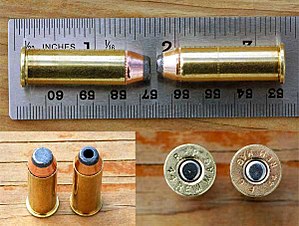.44
| .44 Remington Magnum | ||||||||||||||||||||||||
|---|---|---|---|---|---|---|---|---|---|---|---|---|---|---|---|---|---|---|---|---|---|---|---|---|

.44 Remington Magnum cartridge
|
||||||||||||||||||||||||
| Type | Handgun/Revolver/Rifle | |||||||||||||||||||||||
| Place of origin | United States | |||||||||||||||||||||||
| Production history | ||||||||||||||||||||||||
| Designer | Elmer Keith/Smith & Wesson | |||||||||||||||||||||||
| Designed | 1950s | |||||||||||||||||||||||
| Produced | 1955–Present | |||||||||||||||||||||||
| Specifications | ||||||||||||||||||||||||
| Parent case | .44 S&W Special | |||||||||||||||||||||||
| Bullet diameter | .429 in (10.9 mm) | |||||||||||||||||||||||
| Neck diameter | .457 in (11.6 mm) | |||||||||||||||||||||||
| Base diameter | .457 in (11.6 mm) | |||||||||||||||||||||||
| Rim diameter | .514 in (13.1 mm) | |||||||||||||||||||||||
| Rim thickness | .060 in (1.5 mm) | |||||||||||||||||||||||
| Case length | 1.285 in (32.6 mm) | |||||||||||||||||||||||
| Overall length | 1.61 in (41 mm) | |||||||||||||||||||||||
| Case capacity | 37.9 gr H2O (2.46 cm3) | |||||||||||||||||||||||
| Primer type | Large pistol | |||||||||||||||||||||||
| Maximum pressure | 36,000 psi (250 MPa) | |||||||||||||||||||||||
| Ballistic performance | ||||||||||||||||||||||||
|
||||||||||||||||||||||||
|
Test barrel length: 7.5 in (190 mm) [*6.5 in (170 mm)] Source(s): DoubleTap Buffalo Bore |
||||||||||||||||||||||||
The .44 Remington Magnum, or simply .44 Magnum (10.9×33mmR), and frequently .44 Mag, is a large-bore cartridge originally designed for revolvers. After its introduction, it was quickly adopted for carbines and rifles. Despite the ".44" designation, guns chambered for the .44 Magnum round, and its parent, the .44 Special, use 0.429 in (10.9 mm) diameter bullets.
The .44 Magnum is based on a lengthened .44 Special case, loaded to higher pressures for greater velocity (and thus, energy). The .44 Magnum has since been eclipsed in power by the .454 Casull, and most recently by the .460 S&W Magnum and .500 S&W Magnum, among others; nevertheless, it has remained one of the most popular commercial large-bore magnum cartridges. When loaded to its maximum and with heavy, deeply penetrating bullets, the .44 Magnum cartridge is suitable for short-range hunting of all North American game—though at the cost of heavy recoil and muzzle flash when fired in handguns, less so in carbines and rifles.
The .44 Magnum cartridge was the end result of years of tuned handloading of the .44 Special. The .44 Special, and other large-bore handgun cartridges, were being loaded with heavy bullets, pushed at higher than normal velocities for better hunting performance. One of these handloaders was Elmer Keith, a writer and outdoorsman of the 20th century.
Elmer Keith settled on the .44 Special cartridge as the basis for his experimentation, rather than the larger .45 Colt. At the time, the selection of .44 caliber projectiles for handloaders was more varied, and .44 special brass was thicker and stronger than the dated .45 Colt case. Also, the .44 Special case was smaller in diameter than the .45 Colt case. In revolvers of the same cylinder size, this meant the .44 caliber revolvers had thicker, and thus stronger, cylinder walls than the .45. This allowed higher pressures to be used with less risk of a burst cylinder.
Keith encouraged Smith & Wesson and Remington to produce a commercial version of this new high-pressure loading, and revolvers chambered for it. Smith & Wesson's first .44 Magnum revolver, the Model 29, was built on December 15, 1955, and the gun was announced to the public on January 19, 1956 for a price of $140. Julian Hatcher, (technical editor of American Rifleman) and Elmer Keith received two of the first production models. Hatcher's review of the new Smith & Wesson revolver and the .44 Magnum cartridge appeared in the March, 1956 issue of the magazine. Smith & Wesson produced 3,100 of these revolvers in 1956.
...
Wikipedia
